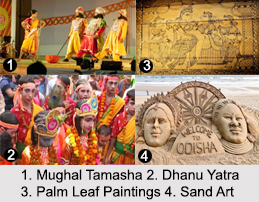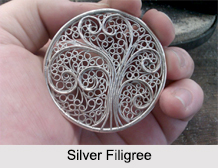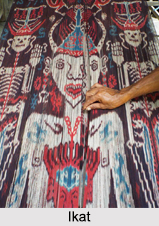 Folk arts of Odisha contain varied art forms of the state. These include the performing arts of dance, music as well as the theatrical performances. The needs and peculiar problems of the life of the village people find an expression in folk art. Thus their life and lifestyle, celebrations, issues, social life and concerns find expression in the various folk art forms.
Folk arts of Odisha contain varied art forms of the state. These include the performing arts of dance, music as well as the theatrical performances. The needs and peculiar problems of the life of the village people find an expression in folk art. Thus their life and lifestyle, celebrations, issues, social life and concerns find expression in the various folk art forms.
Folk Drama and Theatre arts of Odisha
As far as the realm of Oriya folk drama is concerned, it exists in a number of different forms. Following are the different Folk Drama and Theatre arts of Odisha:
Suanga: Suanga is a musical folk theatre. It is widespread in Kalahandi and Balangir districts of western Odisha. All the characters sing, dance and act in this art form.
Leela: This is presented mainly on the event of Holi and Rasa Purnima. People in the village communities in certain parts of Odisha join in singing and dancing to the addition of mridanga and cymbals.
Mughal Tamasha: Mughal Tamasha has positioned itself in the heart of people of Odisha. This dramatic form commenced with an isolated vision to harmonised public differences. The Mughal Tamasha mostly aims to entertain the audiences. Mughal Tamasha is a pure explanation of the then supremacy of Mughal and Maratha. It is an exclusive way of satire to the ministers.
 Jatra: Jatra is a popular folk-theatre form of Bengali theatre as well as in Odisha. Jatras are generally the classic four-hour-long plays, headed by a musical performance often which attracts audiences. The dramatic performance itself is liberally combined by dramatic monologues, songs and duet dance routines on the folk tunes. Jatra plays are usually performed on stages that are open on all sides in open-air arenas.
Jatra: Jatra is a popular folk-theatre form of Bengali theatre as well as in Odisha. Jatras are generally the classic four-hour-long plays, headed by a musical performance often which attracts audiences. The dramatic performance itself is liberally combined by dramatic monologues, songs and duet dance routines on the folk tunes. Jatra plays are usually performed on stages that are open on all sides in open-air arenas.
Danda Nata: Danda Nata or Danda Jatra is one of the most significant traditional dance festivals arranged in dissimilar parts of South Odisha and mainly in the Ganjam District. Danda begins on an auspicious day before the Chaitra Sankranti or Meru Parba with traditional worship and fasting. Only males take part in this festival. The participants are known as the `Bhoktas`.
Dhanu Yatra: Dhanu jatra or Dhanu yatra is an annual drama-based open air theatrical performance celebrated in Bargarh, Odisha. It is based on mythological story of Krishna and his demon uncle Kansa.
Puppet Theatre: The puppet theatre of Odisha is of four main kinds- Shadow puppet, String puppet, Glove puppet and Rod puppet. Shadow puppetry is the show where puppets throw coloured shadows on the screen. The Shadow-theatre of Odisha is known as Ravana Chhaya. It presents the legend of Lord Rama and follows the text of `Vichitra Ramayana` by Vishwanath Khuntia, a medieval Oriya poet.
Dance and Music Arts of Odisha
Odisha brags of a long and rich cultural inheritance. The folk dances of Odisha are very closely linked to the various festivals, celebrations, religious ceremonies and games. Of course, as is the case with any performing art, most of these forms have their local variations depending on the local traditions and lifestyle. Following are the famous Folk Dance and music Arts of Odisha:
Chhau Dance: It has developed into an intricate and highly stylised form of dance over the ages. The dance arrays from celebrating martial arts, acrobatics and athletics presented in cheerful themes of a folk dance, to a structured dance with religious themes found in Shaivism, Shaktism and Vaishnavism.
 Nartaki Dance: The Nartaki dance took place in the majestic courts, where it was much cultivated before the British period. At that time the misuse of devadasis came under strong attack, so that Odissi dance shrunken in the temples and became unfashionable at court. Only the remnants of the Gotipua School stayed and the rebuilding of the style required an archaeological and anthropological effort that has tended to foster a conservative purism.
Nartaki Dance: The Nartaki dance took place in the majestic courts, where it was much cultivated before the British period. At that time the misuse of devadasis came under strong attack, so that Odissi dance shrunken in the temples and became unfashionable at court. Only the remnants of the Gotipua School stayed and the rebuilding of the style required an archaeological and anthropological effort that has tended to foster a conservative purism.
Aside forms of dance in Odisha include Baunsa Rani, Chaiti Ghoda, Changu Nata, Chhau, Dalkhai, Dasakathia, Ghanta Patua, Ghoomra, Jhoomar, Karma, Kathinacha, Kedu, Kela Keluni, Medha Nacha, Naga Dance, Paika Nrutya, Pala, Patua Jatra, Puppet Dance, Rama Leela, Ranappa and Samprada.
Odisha has folk songs which are sung on different festivals and definite occasions for their own pleasure. Of the diversity of folk music of Odisha, the popular folk music is Geeta, Balipuja Geeta, Kela Keluni Geeta, Dalkhai Geeta, Kendra Geeta, Jaiphula Geeta, Ghumura Geeta, Ghoda Nacha and Danda Nacha Geeta, Gopal Ugala and Osa-Parva-Geeta.
Folk art and craft forms of Odisha
Following are the different folk art forms of Odisha:
Pattachitra: Pattachitra is a picture painted on a piece of cloth. This form of art is intimately related to the cult of Shri Jagannath and the temple traditions in Puri. Pattachitra is mainly an icon painting.
Pata Painting: Pata painting is considered an important form of Oriya painting which originated from the temple of Jagannath at Puri in the 12th century. This style developed under the patronage of the Ganga kings, and the kings of Bhoi dynasty.
Applique Works: Applique work in Odisha also originated as a temple art. The artisans of Pipli have their mastery in applique art. Here coloured cloths are stitched in various shapes.
Palm Leaf Paintings: Palm leaf paintings are very antique in Odisha. In Odisha, the Palm Leaf diagrams are mostly of two types, simple engravings or illustrations in pure line on palm leaf and engraving with colour fillings.
Santhal and Saora Paintings: Members of the Saora tribe draw ritualistic drawings on the inner walls of their mud houses called "Ittlans."
Folk Sculptural Art of Odisha
Here is a quick look at the many art forms and crafts which expose the ancient beauty and the refined skills of Odisha"s artisans.
Silver Filigree: The most exceptional and the supreme is silver filigree, locally called "tarakasi". The craft is contained at Cuttack town and a few villages in Cuttack district. The process consists of drawing silver throughout a series of one after the other smaller holes to produce fine strands of wire.
Sand Arts: An exclusive type of art form is developed at Puri. But it extends all over the world. To shape a sand sculpture, the raw material is the only clean and fine grained sand mixed with water.
Stone Carvings: The art of carving in stone has made Odisha reach heights of brilliance wonder through centuries of disciplined endeavours and generations of artisans. The artisans of Odisha have still preserved the wonderful tradition of stone carving which has created a place in the history of art in India.
Brass and Dhokra Works: It is a very old form of craft that is still practiced in some parts of Odisha. Dhokra or bell metal craft is a tribal craft that joins metallurgical skills with wax technique to create things of individual beauty.
Paper Mache: Paper Mache art has been artistically exercised by crafts persons from all over Odisha since long. Masks, hand bags, toys are created out of papers in Odisha.
Horn Bone Craft: Parlakhemundi and Cuttack are famous for this artwork. A lot of utility as well as attractive things are made in this form and the finished products look like the Filmfare lady.
Tassar Patta: Originating from an older tradition of carved painting on the palm leaves, these modern pieces are painted on silk by artists from a village in Odisha who are instructed in this greatly skilled technique.
Ikat: Weaving in this technology started in Odisha. The elaborate method of Ikat is theme to tying in sequences and dyeing the necessary areas in particular colours.
Bottle Art: The bottles are painted in charming Odisha art. It depicts the scenes from the life of Lord Krishna.
Coir Craft: Among the Odisha"s supreme gifts to the arts and crafts of the country are the works of arts made from coir fibre. The trivial, yellow coloured fibre is moulded into animal and bird designs with decorative items.
Terracotta Crafts: Terracotta crafts are made in every part of Odisha. The Terracotta crafts are beautiful in design and bear the traits of the vicinity in which they are fabricated.



















